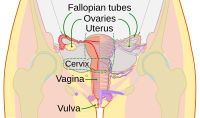
Photo from wikipedia
© BMJ Publishing Group Limited 2022. No commercial reuse. See rights and permissions. Published by BMJ. DESCRIPTION A woman in her late 70s presented to an appointment at the gynaecology… Click to show full abstract
© BMJ Publishing Group Limited 2022. No commercial reuse. See rights and permissions. Published by BMJ. DESCRIPTION A woman in her late 70s presented to an appointment at the gynaecology department due to a growing vaginal mass which she had perceived in the last 2 weeks. She had a history of endometrium serous adenocarcinoma 15 years ago, diagnosed at stage 4 with multiple abdominal metastases, which were identified during surgery and for which she started palliative chemotherapy. She was also diagnosed with an oestrogenreceptor positive breast cancer 5 years ago, which was treated with lumpectomy, radiation therapy and hormone treatment with anastrozole, with the latter being still carried out at the time she presented to us. At gynaecological examination, she exhibited a friable mass, multilobulated, with an irregular surface, exteriorising from the vaginal introitus (figure 1). On speculum examination, we identified a wide insertion of the 60×20 mm mass on the posterior vaginal wall and vaginal vault. Due to the lack of access to perform an adequate complete excision, it was decided to remove the formation through elective surgery, requiring an urgent histology report, which revealed a fibroepithelial stromal vaginal polyp (FSVP) (figure 2). Polypoidal lesions of the vaginal vault are more frequently granulation tissue polyps, typically occurring within weeks after surgery. Fibroepithelial stromal vaginal polyps have been reported uncommonly in the vault and are rare benign growths per se, 3 with a physiopathology that remains elusive. Its hormonal dependence has been widely postulated, supported not only by the immunohistochemical evidence of oestrogen receptors in these lesions but also by their greater prevalence in pregnancy and in postmenopausal women under hormonal replacement therapy. 4 Regarding hormone treatment for breast cancer, an association between FSVP and tamoxifen has been reported in the literature, which can be explained by its oestrogenic effects in tissues other than the breast; however, we did not find reports of any similar cases under treatment with anastrozole, whose mechanism of action through inhibition of aromatase should block oestrogen production and decrease its concentration in all body tissues. We report a rare finding of a fastgrowing FSVP with an uncommon macroscopical appearance in a woman, in her late 70s under hormone treatment with anastrozole and prior oncological history of hormonesensitive tumours. We aim to increase awareness about the benign character of this lesion, besides its atypical appearance and fast growth. Nevertheless, a prompted treatment and definitive diagnosis are crucial to manage the patient’s anxiety.
Journal Title: BMJ Case Reports
Year Published: 2022
Link to full text (if available)
Share on Social Media: Sign Up to like & get
recommendations!